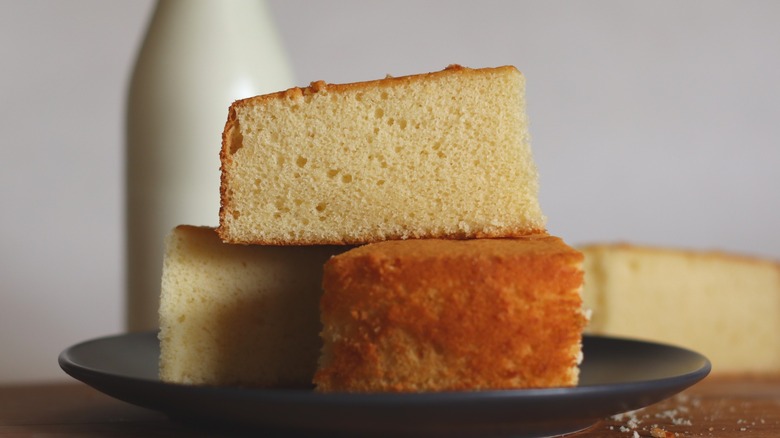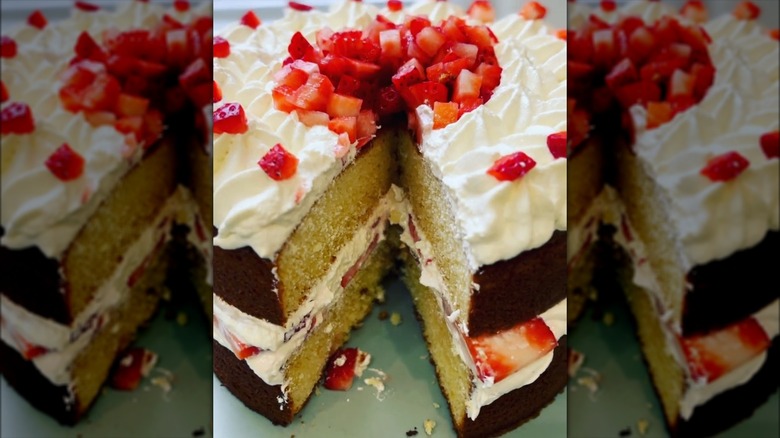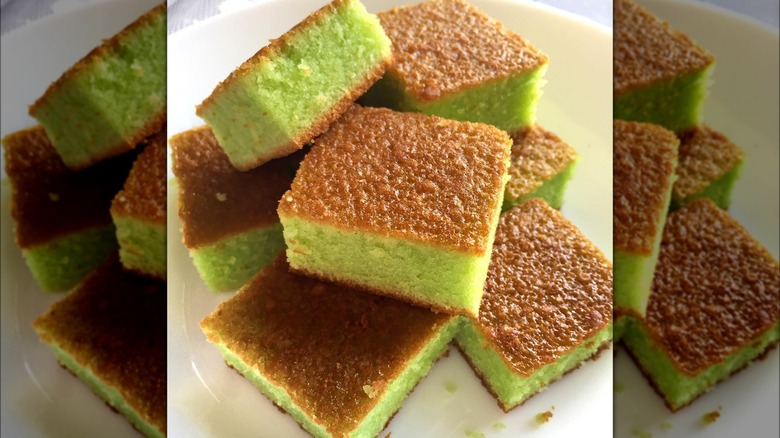What Is Hot Milk Cake And What Does It Taste Like?
The first known printed appearance of hot milk cake was in Chicago Tribune's "Page for Practical Housekeepers" in 1911, with a recipe created by "L.L.M." The ingredients were simple pantry staples: sugar, eggs, flour, salt, baking powder, and hot milk. Then, 44 years later, Chicago Tribune food editor, Ruth Ellen Church, began posting hot milk cake recipes under her pen name, Mary Meade. "The old fashioned hot milk cake isn't a true sponge cake in that it has baking powder to supplement the leavening power of its eggs, but baking powder or not, it is a sponge textured beauty, and many cooks have better success with it than with the true all-egg sponge cake,” Church wrote.
Thanks to their rich, fluffy texture and buttery taste, sponge cakes have long held their status as the go-to cake to impress, but because of the precision needed when making one, they can be intimidating for inexperienced bakers. While hot milk cakes are still light and fluffy, as you would expect from a sponge cake, they're also slightly more dense, with some describing the texture as a cross between a Victoria sponge cake and a pound cake.
Hot milk cake became popular during the Great Depression and World War II
During the 1930s, when items like eggs and sugar were rationed because of World War II, Depression-era items such as mayonnaise cake and hot milk cake were rediscovered, and they might have even been some of your grandma's favorite desserts. Instead of milk, dry milk powder was combined with water, which made the recipe extremely affordable. Hot milk cake got its name from the combination of melted butter and hot milk that's poured into the batter during the mixing process. To prepare a hot milk cake, home bakers would simply beat eggs and sugar together, and then mix in the rest of a sponge cake's standard dry ingredients. After heating the butter and milk almost to boiling, they added the vanilla, and then slowly poured the mixture into the batter.
The addition of baking powder as an extra lifting ingredient for the beaten eggs also made hot milk cakes popular, as it made the recipe much more reliable than that of a regular sponge cake. If a home baker overmixed their batter, or their ingredients weren't evenly distributed or sifted properly, their cake will still rise thanks to the baking powder. Plus, the combination of fat from the butter and oil with the already-melted butter mixed with the milk helped keep the cake soft and moist.
Hot milk cake makes an excellent birthday dessert
There are plenty of recipes for old-fashioned hot milk cake out there — it's simply a one-layer (or bundt) cake with no frosting or topping, except for a dusting of powdered sugar or a dollop of whipped cream. This simple version is perfect with tea or coffee and is also delicious with a topping of jelly or berries. But what's more, the fluffy, buttery cake also works great as a layered birthday cake, with two or three layers and frosting both in between and on top.
Ruth Ellen Church even included a hot chocolate milk cake in her 1955 Mary Meade column, which is still a popular variation. This uncomplicated rendition requires using chocolate milk to heat with the butter, but the modern version often adds cocoa powder to the dry ingredients instead of (or in addition to) the chocolate milk. Using more chocolate will obviously result in a much more intense chocolate flavor.
One popular Southeast Asian variation is the Pandan or Screwpine hot milk cake, which adds coconut milk and uses the Pandan or Screwpine plant's leaves to create a green-hued dessert. An added benefit of this version is that Pandan is thought to have several health benefits, such as relieving arthritis pain and lowering blood sugar levels.


